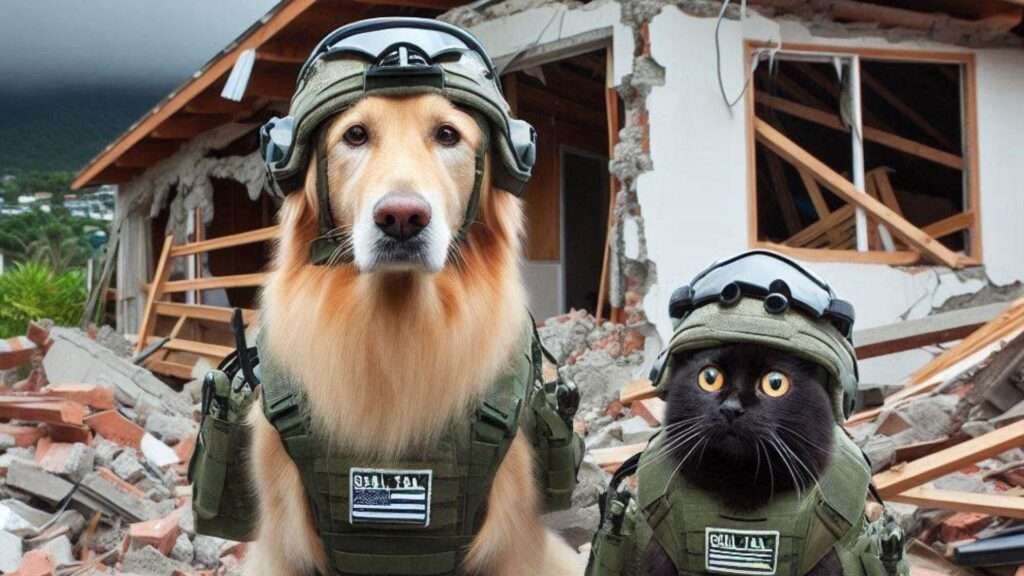Reducing Pet Separation Anxiety.
If you’re like most of us and you have pets that love you very much but unfortunately you have to work for a living and this requires you to be away for a large slice of the week, your pets probably do not like this situation at all.
Let’s be honest, it’s hard sometimes going to work when you know that your pet is experiencing separation anxiety.
I’ve heard of plenty of people that will be driving to work and all they can think about is, “I just wish I could win Lotto, then I’d stop working and then I would not have this situation of me being at work emotionally hurting my pets”.
It’s just so heartbreaking and hard not to think about during the whole day at work.
It’s not as though Fido and Kitty won’t let you know that he/she is not overjoyed with the current arrangement either. Quite commonly when it comes to you do expressing their displeasure with the current arrangement, you’ll be coming home to the aftermath of:
A. Destructive chewing.
B. Urinating on everything.
C. You neighbours rushing over to let you know that they’re not overly happy with almost non-stop barking and whining for the last 9-10 hours.
These are just some of the ways that your pooch will exhibit their stress associated with separation anxiety.
It’s not just dogs who experience this problem either; cats can also be distressed, though they tend to exhibit their worries in more subtle ways, such as excessive grooming.
There is a lot of learning ahead for you if you are on the wrong end of separation anxiety being experienced by your pets.
Only through thoroughly analysing the situation will you develop a plan that works best for you. In the meantime, you might consider leaving something with your smell on it for your pet to help them cope with separation anxiety.
When you’re not around, a blanket or piece of clothing that smells like you can help them feel less lonely.
The Different Ways Cats and Dog Express Separation Anxiety.
As mentioned above, if you are dedicated and loving pet parent, it can be heart-wrenching to leave your furry friends behind when you head off to work or run errands.
You may have noticed that your cat and dog exhibit signs of separation anxiety, which can manifest in different ways for each of them.
Understanding these behaviours and finding ways to address them is crucial for the well-being of your pets and your own peace of mind.
Recognizing Separation Anxiety In Cats and Dogs.
Separation anxiety is a common issue that many pets experience when they are left alone for extended periods.
Dogs and cats, being social animals, thrive on companionship and can feel distressed when their human companions are away.
While dogs often show their anxiety through more obvious behaviours like chewing shoes, urinating indoors, and excessive barking, cats will be different.
Cats display very different signs when it comes to missing you all day.
Cats might exhibit behaviours that seem like anger or resentment with you however, you first need to work out if these behaviours are linked to separation anxiety or is it just generally complex feline emotions in play.
Separation Anxiety with Cats.
Separation anxiety occurs when a cat feels distressed due to being left alone. The behaviours associated with it are typically driven by fear and stress.
Signs of separation anxiety include excessive vocalization, destructive behaviour, and over-grooming.
While some cats may act aloof or distant after their owner returns home, it’s not necessarily a direct expression of anger.
Instead, it could be related to their anxiety about being left alone.
A Quantum Computer Might Not Be Able to Calculate Cat Emotions.
Our Cat Overlords have very complex emotions and they don’t express them in the same way that us inept humans do.
When a cat avoids interaction after you return home from work, it might not be anger. Cats often need time to adjust to changes in their environment or routine.
Some cats prefer gradual reconnection rather than immediate attention. They might need a little space before seeking affection.
Normal Cat Behaviour Is The Very Definition Of Complexity.
Cats are independent creatures. Even if they do miss you terribly during the day, they might not always show it overtly.
Some cats may choose to hide or stay aloof for a while after you return. It’s not necessarily a sign of anger; it could be their way of processing the situation.
In summary, while cats can display behaviours that might appear like anger, it’s essential to consider the context.
If you suspect separation anxiety, observe other signs and consult with your friendly neighbourhood veterinarian.
Remember that each cat is unique, extremely unique, and their reactions can and will vary, just because they can.
Separation anxiety in cats can manifest in various ways when their owners are away. Here are some common signs to watch out for:
Below are some of the more common symptoms to expect:
1. Extreme Attachment: Your cat may cling to you and seek constant attention when you’re around. They won’t want to leave your side and will come for strokes and cuddles.
2. Destructive Scratching: Cats often scratch destructively as a way to de-stress and leave visual and scent markers. This behaviour helps them feel calmer but can be a sign of anxiety.
3. Over-grooming: Some cats excessively groom themselves when you’re about to leave or as you return home. This behaviour may also occur when they’re left alone 1.
4. Anxious Or Strange Behaviours: Look out for signs of nervousness, hiding, blocking doors, or crying when you’re about to leave. These behaviours indicate anxiety related to your absence 1.
5. Inappropriate Behaviours: Your cat might urinate or defecate away from the litter tray, even on clothing, bedding, or furniture. This can happen when they’re left alone.
6. Fast Eating: I don’t understand this one but apparently Cats may eat their food too quickly while you’re out of the house. This behaviour can also be linked to separation anxiety but unless you set up cameras to monitor this, I’m not sure how we can work this one out.
Understanding the Different Expressions From Cats and Dogs.
It’s important to recognize that cats and dogs have distinct ways of expressing their separation anxiety.
Dogs, being highly dependent on their owners, may resort to destructive behaviour as a coping mechanism. Expect some chewing of shoes, furniture, and excessive barking, these are quite common signs that your dog is struggling with your absence.
Here are some tips to help alleviate the dog’s anxiety:
a) Desensitisation: Practice leaving the house without making a big fuss and ignore your dog for a few minutes before leaving and after returning.
b) White Noise or Music: Leaving on soothing music or white noise can help reduce anxiety.
c) Doggy Daycare or Pet Sitters: If possible, consider enrolling your dog in doggy daycare or hiring a pet sitter during work hours.
On the other hand, there are our cats, known for their independent nature, they may withdraw and become distant when they feel anxious.
Ignoring you for a while after you come home could be their way of expressing their displeasure, of which I mentioned prior.
Addressing Separation Anxiety With Cats and Dogs.
There are several steps you can take to help alleviate separation anxiety in both cats and dogs, and while the solution will be similar in some cases, it will be vastly different in others.
1. Establish a routine: Creating a consistent daily routine can provide a sense of security for your pets. Stick to regular feeding times, play sessions, and exercise routines, ensuring they have plenty of mental and physical stimulation.
2. Provide a safe space: Create a designated area in your home where your pets feel comfortable and secure. This could be a cozy corner with their bed, toys, and familiar scents. Having a safe space can help alleviate their anxiety when you’re away.
3. Gradual departures and arrivals: Avoid making a big fuss when leaving or returning home. Gradually desensitise your pets to your comings and goings by practicing short departures and arrivals. This will help them understand that your absence is temporary.
4. Interactive toys and puzzles: Keep your pets mentally stimulated by providing them with interactive toys and puzzles. These toys can help distract them from their anxiety and provide a source of entertainment when you’re not around.
5. Create Safe Spaces: Mainly for cats, you could set up cosy hiding spots or cat trees where the cat can retreat when feeling anxious.
6. Feliway Diffusers: Another Cat specific solution, Feliway is a synthetic feline facial pheromone that can help reduce stress.
a. Plug-in diffusers are available at quality pet shops like Pet Circle or Petbarn, online via Amazon and of course, your local Vet.
7. Get some professional Vet help: If the level of separation anxiety your pets are experiencing persists for too long or actually worsens, it may be beneficial to seek guidance from a veterinarian or a professional animal behaviour specialist. They can assess the situation and provide tailored advice or recommend techniques to help your pets cope.
When In Doubt Always Visit Your Vet.
Visiting your veterinarian is an essential step in addressing separation anxiety in your pets.
I’m not sure why exactly but it seems to me that far too often people leave it too late to visit your Vet for issues that are either physically, mentally or emotionally harming your pet.
Maybe people just do not appreciate how much effort goes into becoming a skilled veterinarian?
The thing is, becoming a quality Vet involves several years of education and training.
I’m guessing it might vary in different countries but from what I understand this is the learning matrix for a Vet in Australia.
1. Step 1 is To Obtain A Bachelor’s Degree: The most basic requirement to become a vet in Australia is to earn a bachelor’s degree in veterinary science. This typically takes around three to four years. During this undergraduate program, people wishing to be Vets gain foundational knowledge in animal health, anatomy, physiology, and other relevant subjects.
2. Step 2 is Post-Graduation Studies: After Vets complete their bachelor’s degree, they don’t just get to sit on their hands and do nothing. Nope, they then need to pursue further education. This involves attending an accredited veterinary school for an additional three to four years. They are then delving deeper into veterinary medicine, clinical skills, and specialized areas such as surgery, diagnostics and animal care. 8 years into being a Vet and they are still not finished.
3. Step 3 is Professional Registration: Once a Vet has successfully completed their vast amount of studies, they then need to register with the Veterinary Practitioners Registration Board or the Veterinary Surgeons Board in your state/country. This registration allows our very highly qualified Vets to practice veterinary medicine legally in that specific state/country.
So yes, Vets and evaluate your cat and dog’s overall health and behaviour, ruling out any underlying medical conditions that may contribute to their anxiety.
Your vet can also provide guidance on behaviour modification techniques; they can suggest calming supplements or medications if necessary and help you develop a comprehensive plan to address the situation.
Remember, patience and understanding is the key when it comes to dealing with separation anxiety in your pets.
With consistent effort and the right approach, you can help your cat and/or dog feel more secure and content when you’re away.
By addressing their separation anxiety, you’ll not only enhance their well-being but also strengthen the bond you share with your beloved furry companions.











